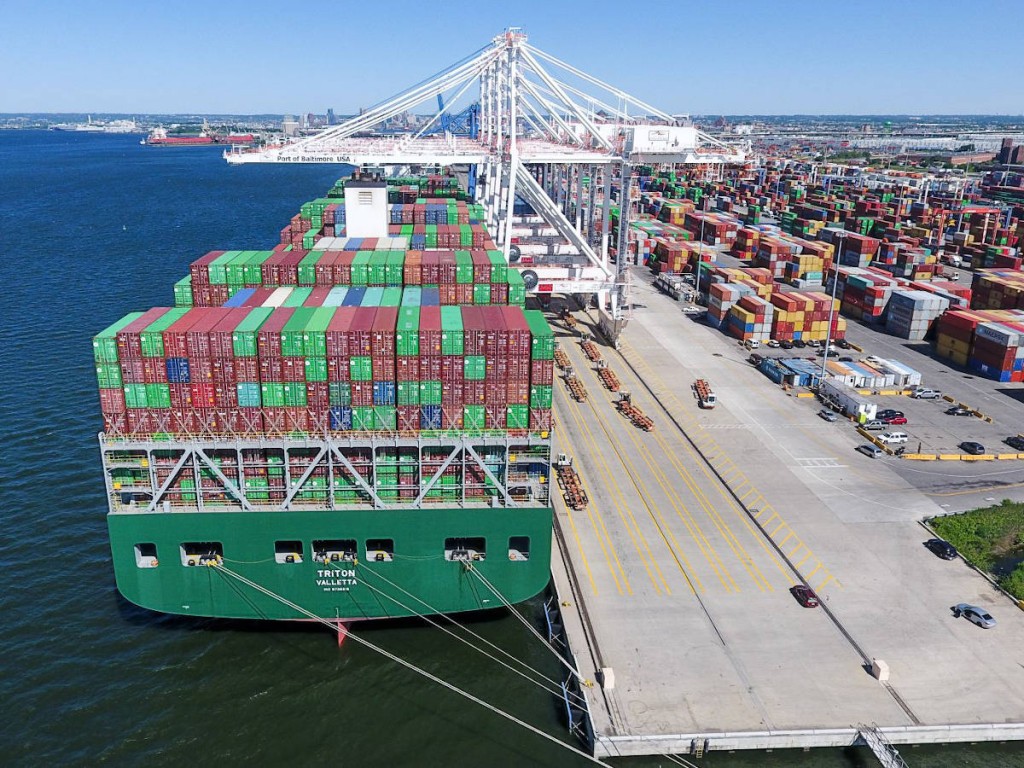Additional ultra-large cranes will arrive this summer and will allow the port to handle two massive ships simultaneously
The Helen Delich Bentley Port of Baltimore completed dredging operations this week to create a second, 50-foot deep container berth at its Seagirt Marine Terminal. The project, accomplished as part of the public-private partnership between the Maryland Department of Transportation Maryland Port Administration (MDOT MPA) and Ports America Chesapeake, will allow the Port to accommodate two ultra-large ships simultaneously by the end of this year.

During his visit to the Port of Baltimore in March, the governor took a boat ride to a dredger vessel to view the operation and visit the crew. Dredging, which began in January and concluded April 20, was conducted by Corman Kokosing of Annapolis Junction, The company used two dredges, Koko V and Koko VI, and the SN3 unloader barge to remove more than 465,000 cubic yards of sediment. The sediment was taken to the Masonville dredged material containment facility in Baltimore and will be reused for land restoration and other purposes.
With the second 50-foot deep berth completed, four additional Neo-Panamax cranes will arrive this summer and will be operational later this year. The berth project is part of a $122.1 million investment, with $105 million from Ports America, $10.5 million from the state and $6.6 million in federal funding. Ports America Chesapeake is also investing an additional $61 million into Seagirt for additional equipment, infrastructure enhancements and technology upgrades.
“The Port of Baltimore and its skilled workforce have always played a key role in supporting Maryland’s economy and keeping the state’s supply chain open and reliable,” MDOT Secretary Greg Slater said. “Now, together with our public and private partners, we’re seeing the future of the Port take shape. Additional berth capacity and the ability to move cargo on double-stacked rail cars with the Howard Street Tunnel expansion will attract new and expanded business to the Port, boost revenue, grow jobs and lead the way in Maryland’s economic recovery.”
The planned expansion of the 126-year-old Howard Street Tunnel in Baltimore will accommodate double-stacked rail cars moving cargo to and from the Port, improving capacity from Baltimore to rail lines up and down the East Coast. That project is also benefitting from public-private investment between the federal government, Maryland, CSX and others. Pending final National Environmental Policy Act approval, CSX will complete final engineering and permitting, with construction expected late this year.
“We’re moving forward in the Port of Baltimore,” said MDOT MPA Executive Director William P. Doyle. “We appreciate the on-time and on-budget dredging work completed by Maryland-based Corman Kokosing, a great U.S.-flag dredging and marine construction operator. This summer we’ll welcome four new Neo Panamax cranes and later this year we’ll break ground on the Howard Street Tunnel project, giving the Port and CSX double stack capability north, south and all the way out to Chicago. These are very exciting times for the Port of Baltimore.”
The public-private partnership between MDOT MPA and Seagirt operator Ports America Chesapeake was signed in 2010 in the wake of a national recession. The P3 has generated thousands of jobs and continues to result in increased tax revenue for the state and funds for the Transportation Trust Fund.
“We’re very excited to be moving forward on this project which will greatly enhance container operations at the Port of Baltimore,” said Ports America Chesapeake Vice President Bayard Hogans. ”Ports America Chesapeake is also making other significant investments in upgrades at Seagirt Marine Terminal including additional yard equipment, new truck gates, and advanced technology. All of these initiatives are contributing to increasing the Port’s capacity and efficiency — and ultimately support future growth.”
“Completing the second, 50-foot deep berth is great news for the labor force of the Port of Baltimore,” said Scott Cowan, president of International Longshoremen’s Association Local 333. “The men and women of ILA 333 are looking forward to the opportunities to work even more larger ships and handle higher amounts of cargo.”
The Port of Baltimore generates about 15,300 direct jobs, with nearly 140,000 jobs overall linked to Port activities. The Port ranks first among the nation’s ports for volume of autos and light trucks, roll on/roll off heavy farm and construction machinery, and imported gypsum. It ranks 11th among major U.S. ports for foreign cargo handled and 10th for total foreign cargo value.
The health and safety of the Port of Baltimore workforce is paramount, and the public marine terminals have maintained stringent CDC-recommended health and safety guidelines to ensure the safety of its labor force, tenants and partners. MDOT MPA encourages the use of face coverings and social distancing measures for individuals working at the marine terminals, and encourages teleworking for those able to do so. Temperature screenings and other preventative procedures are also continuing.











